AIRC: Attentive Implicit Relation Recommendation Incorporating Content Information for Bipartite Graphs
Abstract
1. Introduction
- The first challenge we address is to leverage both the characteristic of bipartite graphs and the auxiliary information. In bipartite graphs, only the structure information is presented by the relations between users and items. Through incorporating both the content information and the bipartite graph structure, we can improve not only the model accuracy but also the cold-start problem.
- Both homogenous and heterogeneous network algorithms take into account the explicit relations between two types of vertices. However, there are implicit relations between the same type of vertices in bipartite graphs. For example in Figure 1, where and are two sets of vertices with different types, E is the set of edges, labeled with weights . The edge can represent the interaction between user and item , for example the rating that a user gives to an item. Suppose it is a user-movie graph. User 1 and user 2 should have an implicit relation as they share the same interest in movie 1. When embedding those users into low-dimensional spaces, they should be neighbors with similar vectors, thus more likely to be recommended to the same preferred movies. As discussed in [20], modeling both relation types will improve the recommendation accuracy.
- We define the user implicit relation graph the same way we define the item implicit relation graph, as where users are linked if they have relations to the same item in the bipartite graph. As a result, similar users/items become neighbors. In order to preserve the similarity during embedding, we resort to the solution of graph attention mechanisms such as graph attention networks (GATs) [21]. GAT is based on graph convolution algorithms, which leverages features of neighbors from a node by learning different weights of different neighbors. Thus, the implicit relations are preserved by embedding similar nodes with close vectors.
- We incorporate content information in our framework. We train both user and item features through a simple CNN, yields user and item feature vectors. Then we represent each node in the user graph and item with the feature vectors, so that nodes with similar feature vectors can affect each other more in a neighborhood during the GAT process and also reduce the problem of a cold-start.
- With the user–item bipartite graph, we add a graph attention layer into GC–MC as side information, and trained together to obtain the final embedding of each user and item. The structure of our framework is shown in Figure 2. A bipartite graph is reconstructed into user and item implicit relation graphs, and through a simple CNN operation we obtain a pretrained feature matrix. Those matrices are then fed into a graph attention mechanism applied on the implicit graphs, whereby becomes side information and trained together with GC–MC algorithm. The structure will be in detail explained in Section 3.
2. Related Work
3. Proposed Work
3.1. Implicit Relation Graph Generation
3.2. Content Information Extranction
3.2.1. CNN Process
3.2.2. Attention Mechanism
3.3. Structure
| Algorithm 1. Attentive implicit relation recommendation incorporating content information (AIRC). |
| Input: Bipartite graph , content information and Output: Embeddings and , prediction 1: Partition into and according to Def. 1 2: user feature matrix 3: item feature matrix 4: for i = 1,…, max_iter do 5: GCN layer: user initial embedding: Item initial embedding: 6: Attention layer User attentive embedding: Item attentive embedding: 7: Dense layer: user hidden representation: item hidden representation: 8: Decoder: rate prediction: 9: Train phase: update parameter by gradient descent minimizing L 10: end for |
4. Experiment
4.1. Dataset
4.2. Baseline
4.3. Evaluation Metrics
4.4. Results and Discussion
5. Conclusions
Author Contributions
Funding
Conflicts of Interest
References
- Hu, X.; Mai, Z.; Zhang, H.; Xue, Y.; Zhou, W.; Chen, X. A hybrid recommendation model based on weighted bipartite graph and collaborative filtering. In Proceedings of the International Conference on Web Intelligence Workshops, Omaha, NE, USA, 13–16 October 2016; pp. 119–122. [Google Scholar]
- Covington, P.; Adams, J.; Sargin, E. Deep Neural Networks for Youtube Recommendations. 2016. Available online: https://static.googleusercontent.com/media/research.google.com/en//pubs/archive/45530.pdf (accessed on 20 December 2019).
- Wang, H.; Zhang, F.; Xie, X.; Guo, M. DKN: Deep knowledge-aware network for news recommendation. In Proceedings of the 27th International Conference on World Wide Web (WWW’18), Lyon, France, 23–27 April 2018; pp. 1835–1844. [Google Scholar]
- Cheng, H.; Koc, L.; Harmsen, J.; Shaked, T.; Chandra, T.; Aradhye, H.; Anderson, G.; Corrado, G.; Chai, W.; Ispir, M.; et al. Wide & deep learning for recommender systems. arXiv 2016, arXiv:1606.07792. [Google Scholar]
- Hu, B.; Shi, C.; Zhao, W.X.; Yu, P.S. Leveraging meta-path based context for top-n recommendation with a neural co-attention model. In Proceedings of the Knowledge Discovery in Databases, Dublin, Ireland, 10–14 September 2018; pp. 1531–1540. [Google Scholar]
- Li, J.; Ren, P.; Chen, Z.; Ren, Z.; Ma, J. Neural attentive session-based recommendation. arXiv 2017, arXiv:1711.04725. [Google Scholar]
- Robin, D.; Hugues, B. Long and short-term recommendations with recurrent neural networks. arXiv 2017, arXiv:1608.07400. [Google Scholar]
- Baocheng, W.; Wentao, C. Attention-Enhanced Graph Neural Networks for Session-Based Recommendation. Mathematics 2020, 8, 1607. [Google Scholar]
- Wu, C.Y.; Ahmed, A.; Beutel, A.; Smola, A.J.; Jing, H. Recurrent Recommender Networks. In Proceedings of the 10th ACM International Conference on Web Search and Data Mining (WSDM’17), New York, NY, USA, 6 February 2017; Association for Computing Machinery: New York, NY, USA, 2017; pp. 495–503. [Google Scholar]
- Ying, R.; He, R.; Chen, K.; Eksombatchai, P.; Hamilton, W.L.; Leskovec, J. Graph convolutional neural networks for web-scale recommender systems. arXiv 2018, arXiv:1806.01973. [Google Scholar]
- Kipf, T.N.; Welling, M. Semi-supervised classification with graph convolutional networks. arXiv 2016, arXiv:1609.02907. [Google Scholar]
- Grover, A.; Leskovec, J. Node2vec: Scalable feature learning for networks. In Proceedings of the Knowledge Discovery in Databases, Riva del Garda, Italy, 19–23 September 2016; pp. 855–864. [Google Scholar]
- Deng, H.; Lyu, M.R.; King, I. A generalized co-hits algorithm and its application to bipartite graphs. In Proceedings of the Knowledge Discovery in Databases, Bled, Slovenia, 7–11 September 2009; pp. 239–248. [Google Scholar]
- Jiang, S.; Hu, Y.; Kang, C.; Daly, T., Jr.; Yin, D.; Chang, Y.; Zhai, C. Learning query and document relevance from a web-scale click graph. In Proceedings of the Special Interest Group on Information Retrieval, Pisa, Italy, 17–21 July 2016; pp. 185–194. [Google Scholar]
- He, X.; Gao, M.-Y.; Kan, M.; Wang, D. Birank: Towards ranking on bipartite graphs. arXiv 2017, arXiv:1708.04396. [Google Scholar] [CrossRef]
- Van den Berg, R.; Kipf, T.N.; Welling, M. Graph convolutional matrix completion. arXiv 2017, arXiv:1706.02263. [Google Scholar]
- Ming, G.; Leihui, C.; Xiangnan, H.; Aoying, Z. BiNE: Bipartite network embedding. In Proceedings of the 41st International ACM SIGIR Conference on Research & Development in Information Retrieval, Ann Arbor, MI, USA, 8–12 July 2018; pp. 715–724. [Google Scholar]
- Yu, L.; Zhang, C.; Pei, S.; Sun, G.; Zhang, X. WalkRanker: A unified pairwise ranking model with multiple relations for item recommendation. In Proceedings of the Association for the Advancement of Artificial Intelligence, New Orleans, LA, USA, 2–7 February 2018. [Google Scholar]
- Veličković, P.; Cucurull, G.; Casanova, A.; Romero, A.; Liò, P.; Bengio, Y. Graph attention networks. arXiv 2017, arXiv:1710.10903. [Google Scholar]
- Ali, F.; El-Sappagh, S.; Islam, S.M.R.; Ali, A.; Kwak, K.-S. An Intelligent Healthcare Monitoring Framework Using Wearable Sensors and Social Networking Data. In Future Generation Computer Systems; Elsevier: Amsterdam, The Netherlands, 2020; Volume 114, pp. 23–43. [Google Scholar]
- Ayvaz, E.; Kaplan, K.; Kuncan, M. An integrated LSTM neural networks approach to sustainable balanced scorecard-based early warning system. IEEE Access 2020, 8, 37958–37966. [Google Scholar] [CrossRef]
- Dziugaite, G.K.; Roy, D.M. Neural network matrix factorization. arXiv 2015, arXiv:1511.06443. [Google Scholar]
- Zheng, L.; Lu, C.-T.; He, L.; Xie, S.; Noroozi, V.; Huang, H.; Yu, P.S. MARS: Memory attention-aware recommender system. arXiv 2018, arXiv:1805.07037. [Google Scholar]
- Hamilton, W.; Ying, Z.; Leskovec, J. Inductive representation learning on large graphs. In Proceedings of the Neural Information Processing Systems, Long Beach, CA, USA, 4–9 December 2017; pp. 1024–1034. [Google Scholar]
- Yifan, H.; Hongzhi, C.; Changji, L.; James, C.; Ming-Chang, Y. A representation learning framework for property graphs. In Proceedings of the 25th ACM SIGKDD International Conference on Knowledge Discovery & Data Mining, Anchorage, AK, USA, 3–7 August 2019; pp. 65–73. [Google Scholar]
- Xiao, H.; Qingquan, S.; Yuening, L.; Xia, H. Graph recurrent networks with attributed random walks. In Proceedings of the 25th ACM SIGKDD International Conference on Knowledge Discovery & Data Mining, Anchorage, AK, USA, 3–7 August 2019; pp. 732–740. [Google Scholar]
- Hongbo, D.; Michael, L.; Irwin, K. A generalized co-HITS algorithm and its application to bipartite graphs. In Proceedings of the 15th ACM SIGKDD International Conference on Knowledge Discovery and Data Mining, Paris, France, 28 June–1 July 2009; pp. 239–248. [Google Scholar]
- Xiang, W.; Xiangnan, H.; Yixin, C.; Meng, L.; Chua, T.-S. KGAT: Knowledge graph attention network for recommendation. In Proceedings of the 25th ACM SIGKDD International Conference on Knowledge Discovery & Data Mining, Anchorage, AK, USA, 3–7 August 2019; pp. 950–958. [Google Scholar]
- Sperduti, A.; Starita, A. Supervised neural networks for the classification of structures. IEEE Trans. Neural Netw. 1997, 8, 714–735. [Google Scholar] [CrossRef] [PubMed]
- Gori, M.; Monfardini, G.; Scarselli, F. A new model for learning in graph domains. In Proceedings of the IEEE International Joint Conference of Neural Networks, Montreal, QC, Canada, 31 July–4 August 2005; pp. 729–734. [Google Scholar]
- John, L.; Ryan, R.; Xiangnan, K. Graph classification using structural attention. In Proceedings of the 24th ACM SIGKDD International Conference on Knowledge Discovery & Data Mining, London, UK, 19–23 August 2018; pp. 1666–1674. [Google Scholar]
- MovieLens Based Recommender System. Available online: http://blog.csdn.net/chengcheng1394/article/details/78820529 (accessed on 15 December 2019).
- Kim, Y. Convolutional neural networks for sentence classification. arXiv 2014, arXiv:1408.5882. [Google Scholar]
- Mnih, V.; Heess, N.; Graves, A.; Kavukcuoglu, K. Recurrent models of visual attention. arXiv 2014, arXiv:1406.6247. [Google Scholar]
- Xu, K.; Ba, J.; Kiros, R.; Cho, K.; Courville, A.; Salakhutdinov, R.; Zemel, R.; Bengio, Y. Show, attend and tell: Neural image caption generation with visual attention. arXiv 2015, arXiv:1502.03044. [Google Scholar]
- Bahdanau, D.; Cho, K.; Bengio, Y. Neural machine translation by jointly learning to align and translate. arXiv 2014, arXiv:1409.0473. [Google Scholar]
- Vaswani, A.; Shazeer, N.; Parmar, N.; Uszkoreit, J.; Jones, L.; Gomez, A.N.; Kaiser, L.; Polosukhin, I. Attention is all you need. arXiv 2017, arXiv:1706.03762. [Google Scholar]
- Dai, H.; Dai, B.; Song, L. Discriminative embeddings of latent variable models for structured data. In Proceedings of the International Conference on Machine Learning (ICML), New York City, NY, USA, 19–24 June 2016; pp. 2702–2711. [Google Scholar]
- Recht, E.J.C.B. Exact matrix completion via convex optimization. arXiv 2012, arXiv:0805.4471. [Google Scholar]
- Monti, F.; Bronstein, M.M.; Bresson, X. Geometric matrix completion with recurrent multi-graph neural networks. In Proceedings of the Advances in Neural Information Processing Systems, Long Beach, CA, USA, 4–9 December 2017; pp. 3697–3707. [Google Scholar]
- Wang, H.; Wang, N.; Yeung, D.-Y. Collaborative deep learning for recommender systems. In Proceedings of the 21th ACM SIGKDD International Conference on Knowledge Discovery and Data Mining, Sydney, Australia, 10–13 August 2015; pp. 1235–1244. [Google Scholar]
- Kalofolias, V.; Bresson, X.; Bronstein, M.; Vandergheynst, P. Matrix completion on graphs. arXiv 2014, arXiv:1408.1717. [Google Scholar]
- Mnih, A.; Salakhutdinov, R.R. Probabilistic matrix factorization. In Proceedings of the Advances in Neural Information Processing Systems, Vancouver, BC, Canada, 8–10 December 2008; pp. 1257–1264. [Google Scholar]
- Sedhain, S.; Menon, A.K.; Sanner, S.; Xie, L. Autorec: Autoencoders meet collaborative filtering. In Proceedings of the 24th International Conference on World Wide Web, Florence, Italy, 18–22 May 2015; pp. 111–112. [Google Scholar]
- Antoine, B.; Nicolas, U.; Alberto, G.-D.; Jason, W.; Oksana, Y. Translating embeddings for modeling multi-relational data. In Proceedings of the Advances in Neural Information Processing Systems, Lake Tahoe, NV, USA, 5–10 December 2013; pp. 2787–2795. [Google Scholar]
- Han, X.; Minlie, H.; Yu, H.; Xiaoyan, Z. TransA: An adaptive approach for knowledge graph embedding. arXiv 2015, arXiv:1509.05490. [Google Scholar]
- Guo, H.; Tang, R.; Ye, Y.; Li, Z.; He, X. DeepFM: A factorization-machine based neural network for CTR prediction. arXiv 2017, arXiv:1703.04247. [Google Scholar]
- Zheng, L.; Noroozi, V.; Yu, P.S. Joint deep modeling of users and items using reviews for recommendation. arXiv 2017, arXiv:1701.04783. [Google Scholar]
- Ying, H.; Zhuang, F.; Zhang, F.; Liu, Y.; Xu, G.; Xie, X.; Xiong, H.; Wu, J. Sequential recommender system based on hierarchical attention networks. In Proceedings of the IJCAI International Joint Conference on Artificial Intelligence, Stockholm, Sweden, 13–19 July 2018; pp. 3926–3932. [Google Scholar]
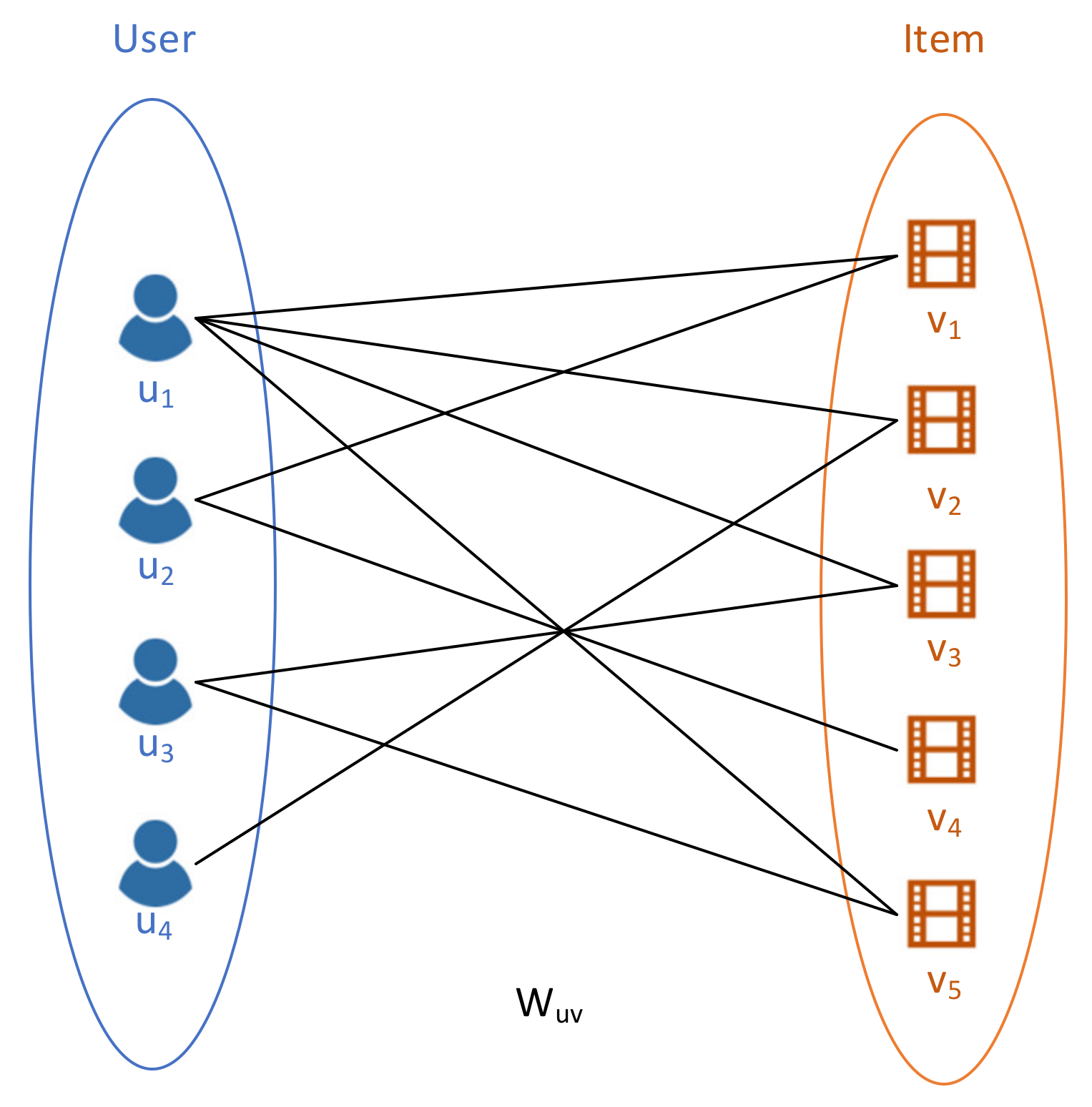
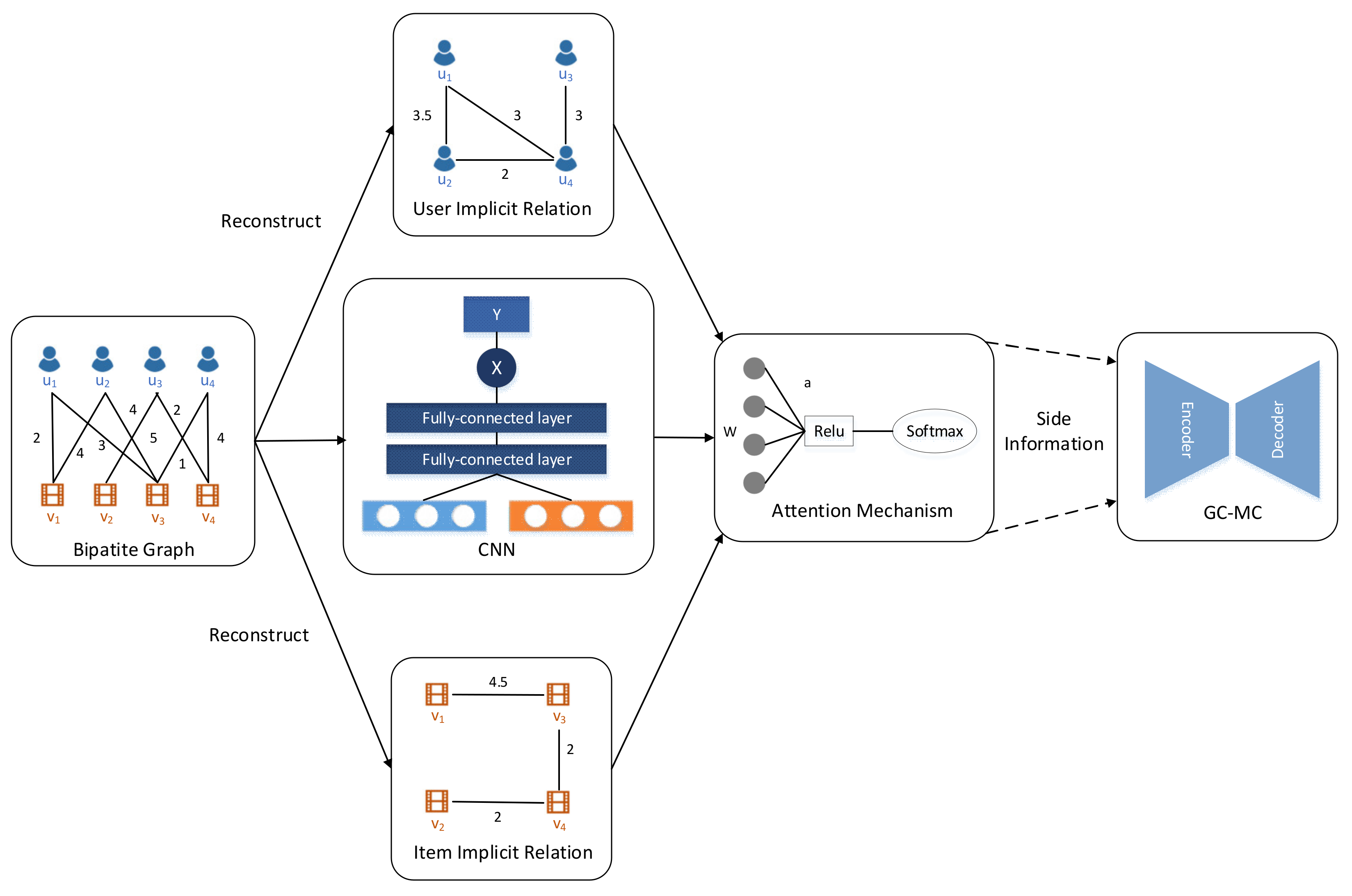
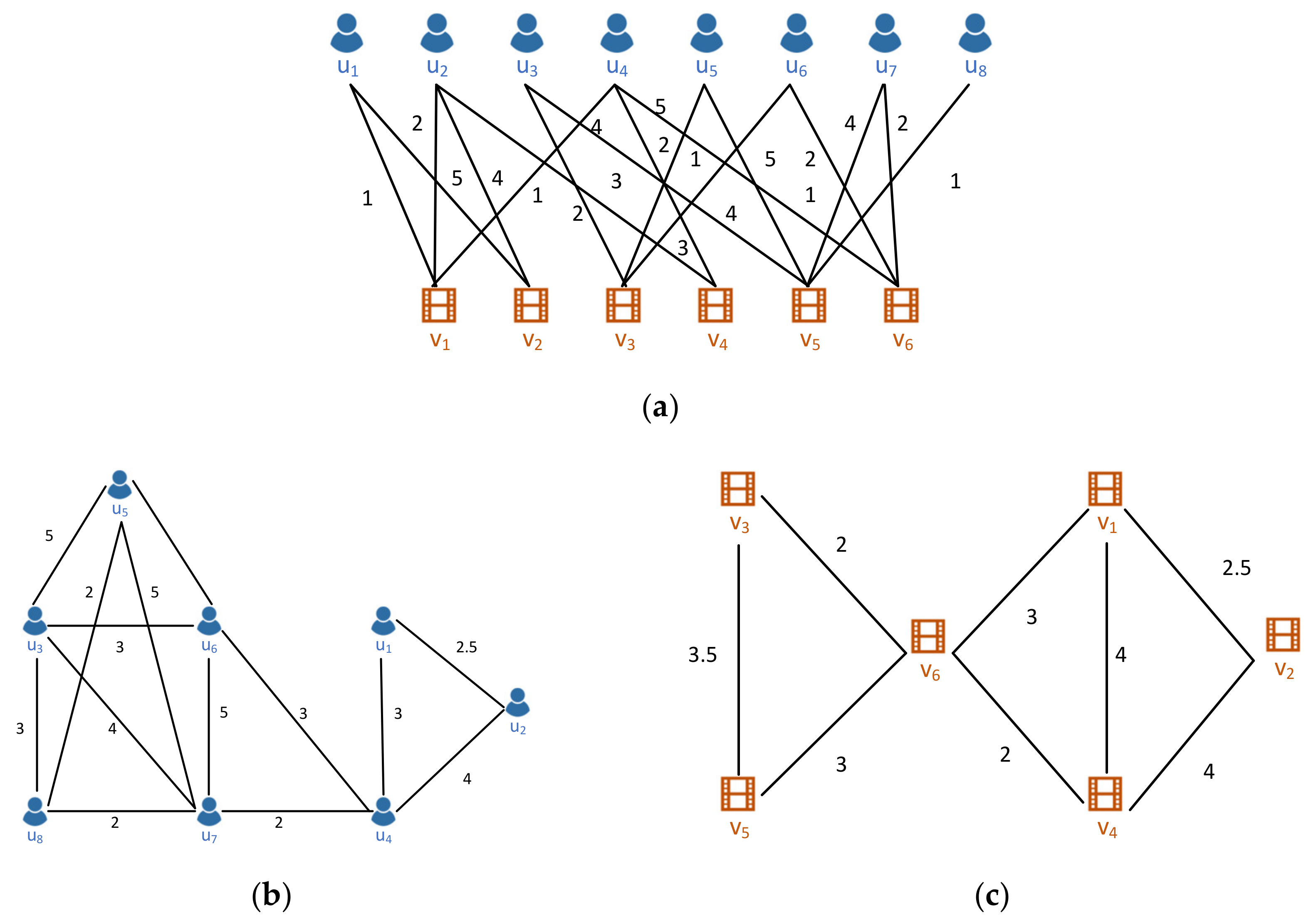
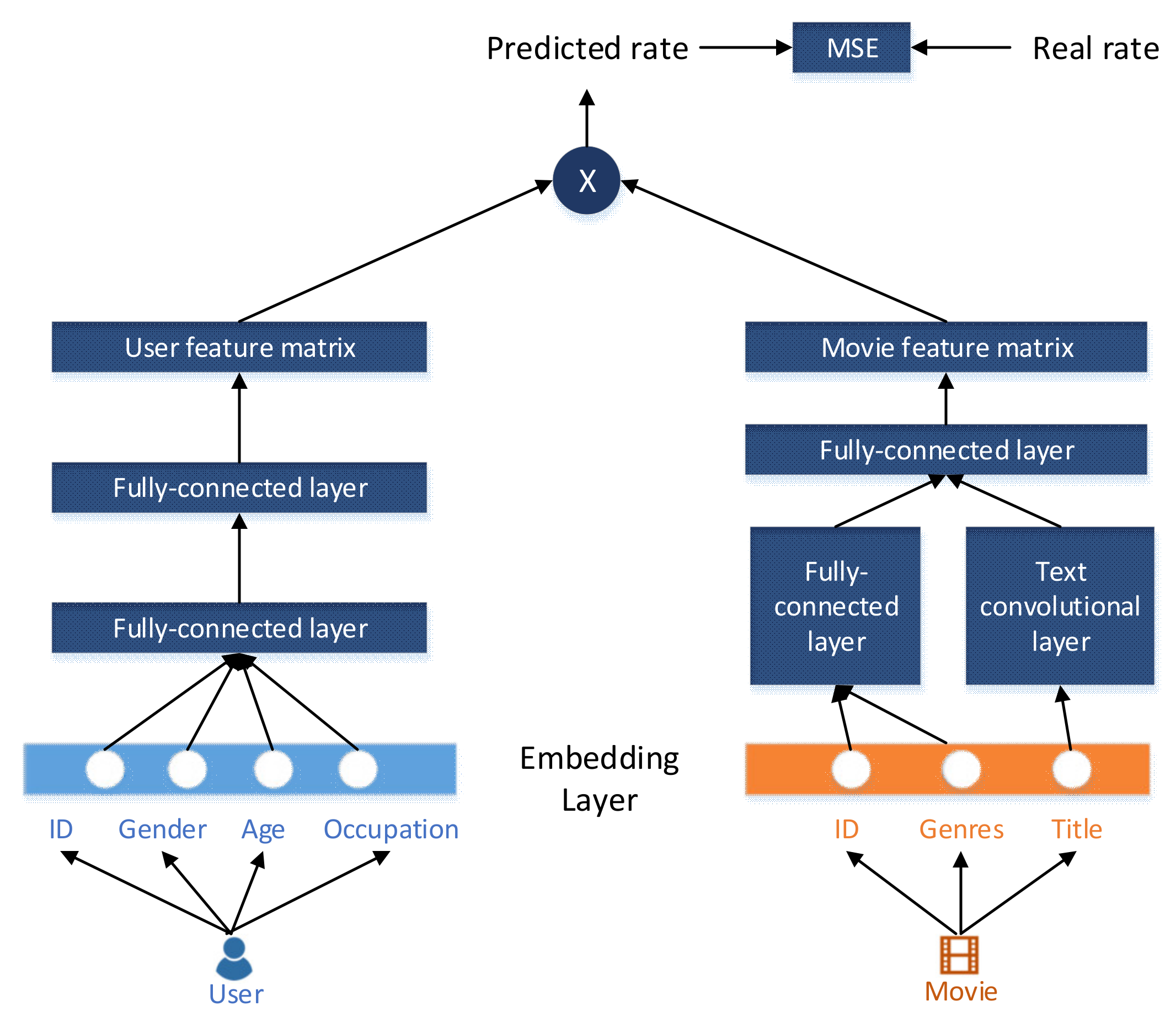
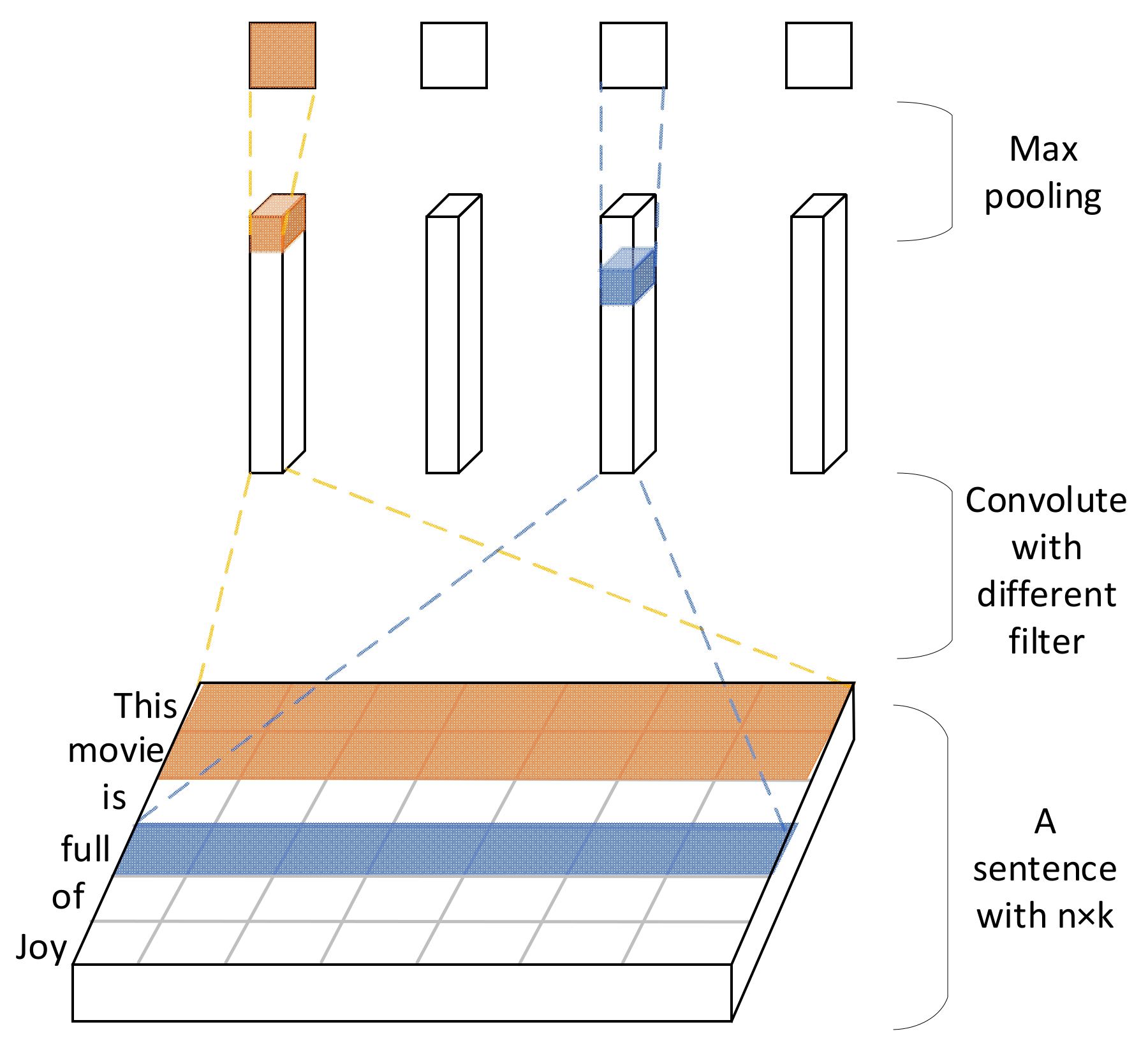
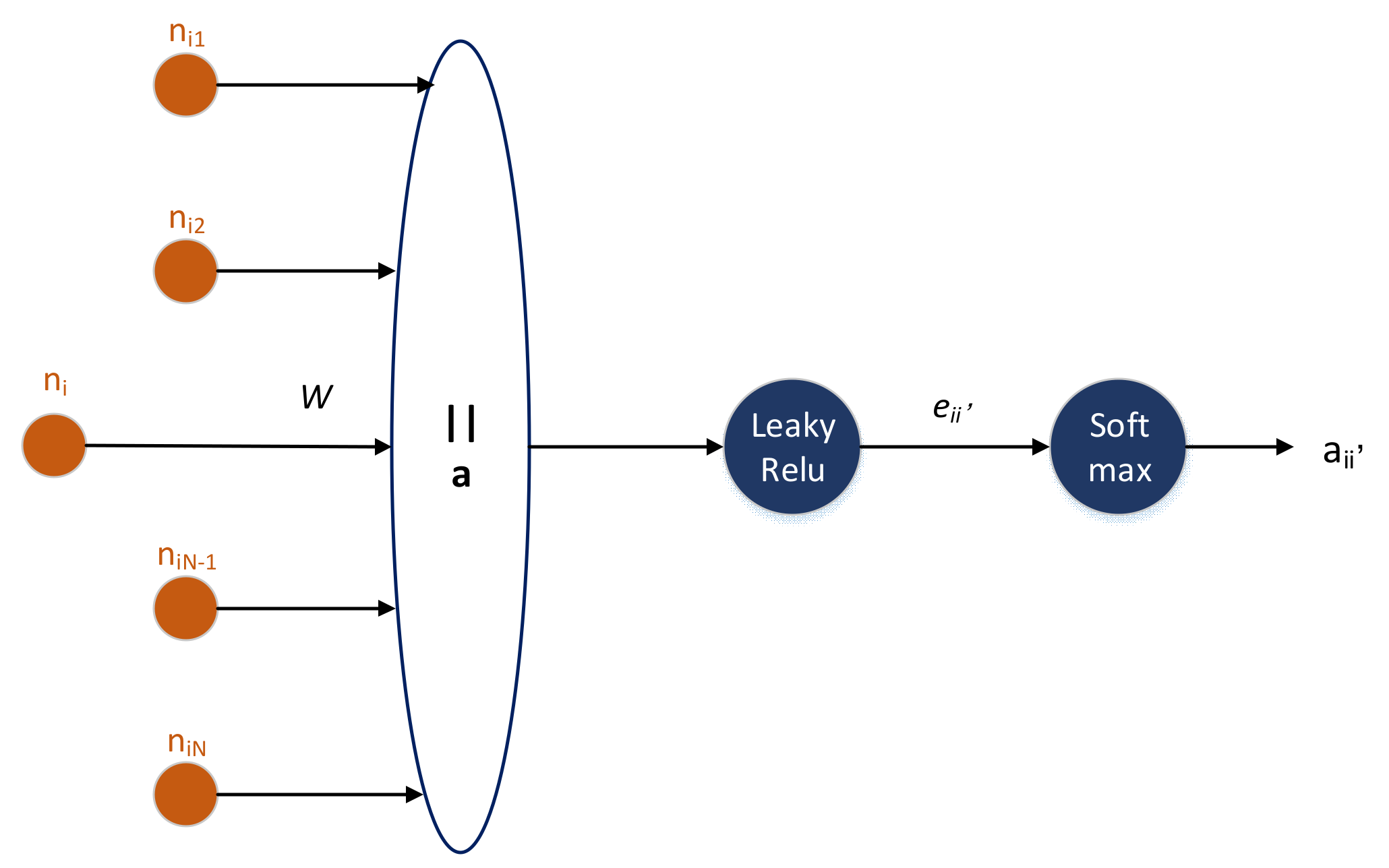
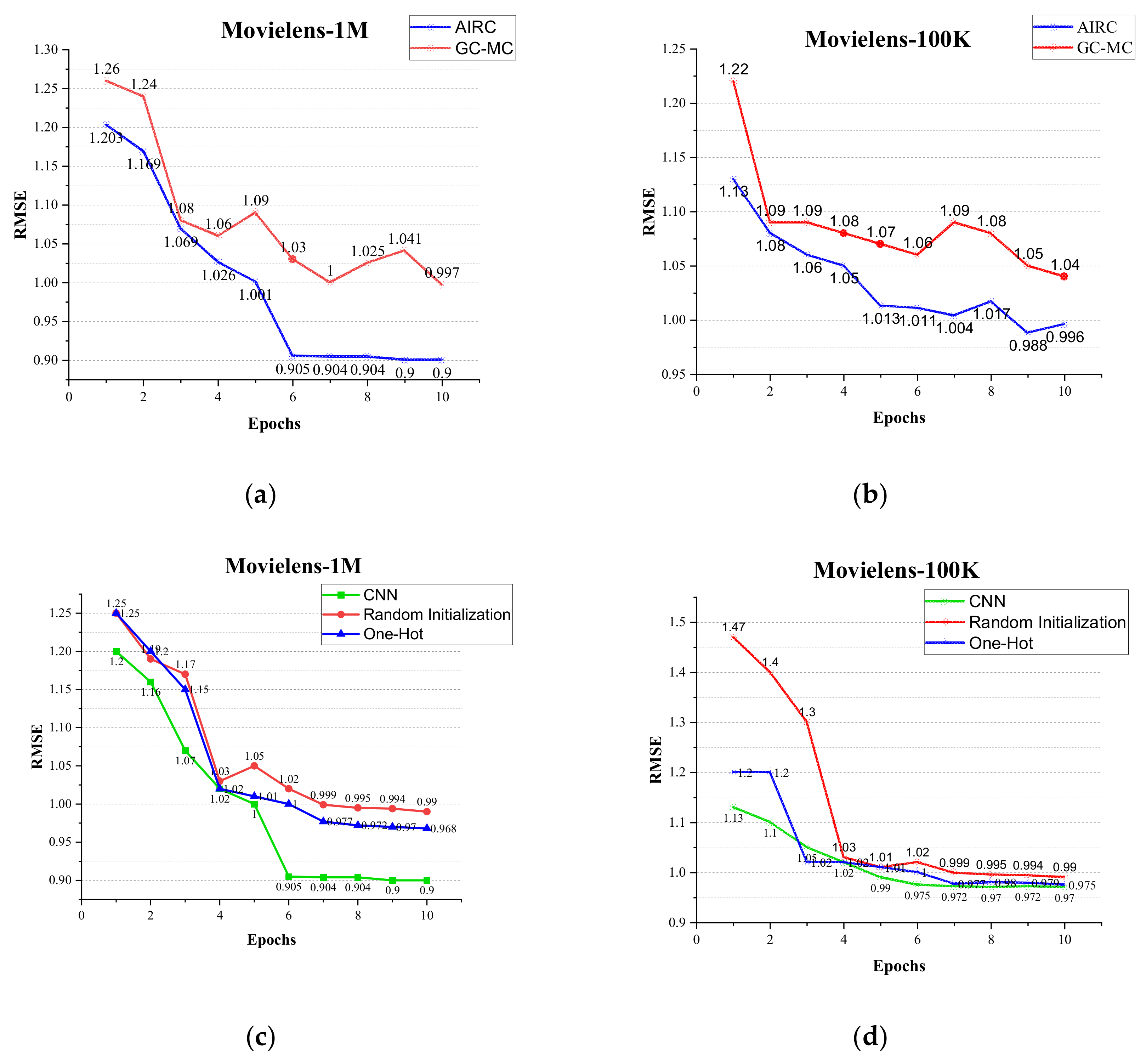
| Age | Encode |
|---|---|
| Under 18 | 1 |
| 18–24 | 18 |
| 25–34 | 25 |
| 35–44 | 35 |
| 45–49 | 45 |
| 50–55 | 50 |
| Over 56 | 56 |
| Dataset | Items | Users | Ratings | Density |
|---|---|---|---|---|
| Movielens-1M | 3706 | 6040 | 1,000,209 | 0.0447 |
| Movielens-100K | 1682 | 943 | 100,000 | 0.0630 |
| Dataset | Graph | No. Nodes | No. Edges |
|---|---|---|---|
| Movielens-1M | User IRG | 3706 | 9,469,555 |
| Item IRG | 6040 | 32,721,414 | |
| Movielens-100K | User IRG | 943 | 859,323 |
| Item IRG | 1682 | 1,574,374 |
| Algorithm | RMSE |
|---|---|
| MC | 0.973 |
| GMC | 0.996 |
| sRGCNN | 0.929 |
| GC–MC (with features) | 0.910 |
| AIRC (Ours) | 0.892 |
| Algorithm | RMSE |
|---|---|
| PMF | 0.883 |
| U-AutoRec | 0.874 |
| NNMF | 0.843 |
| GC–MC (with features) | 0.832 |
| AIRC (Ours) | 0.821 |
Publisher’s Note: MDPI stays neutral with regard to jurisdictional claims in published maps and institutional affiliations. |
© 2020 by the authors. Licensee MDPI, Basel, Switzerland. This article is an open access article distributed under the terms and conditions of the Creative Commons Attribution (CC BY) license (http://creativecommons.org/licenses/by/4.0/).
Share and Cite
Ma, X.; Dong, L.; Wang, Y.; Li, Y.; Sun, M. AIRC: Attentive Implicit Relation Recommendation Incorporating Content Information for Bipartite Graphs. Mathematics 2020, 8, 2132. https://doi.org/10.3390/math8122132
Ma X, Dong L, Wang Y, Li Y, Sun M. AIRC: Attentive Implicit Relation Recommendation Incorporating Content Information for Bipartite Graphs. Mathematics. 2020; 8(12):2132. https://doi.org/10.3390/math8122132
Chicago/Turabian StyleMa, Xintao, Liyan Dong, Yuequn Wang, Yongli Li, and Minghui Sun. 2020. "AIRC: Attentive Implicit Relation Recommendation Incorporating Content Information for Bipartite Graphs" Mathematics 8, no. 12: 2132. https://doi.org/10.3390/math8122132
APA StyleMa, X., Dong, L., Wang, Y., Li, Y., & Sun, M. (2020). AIRC: Attentive Implicit Relation Recommendation Incorporating Content Information for Bipartite Graphs. Mathematics, 8(12), 2132. https://doi.org/10.3390/math8122132





